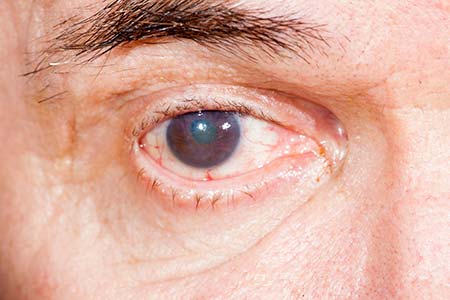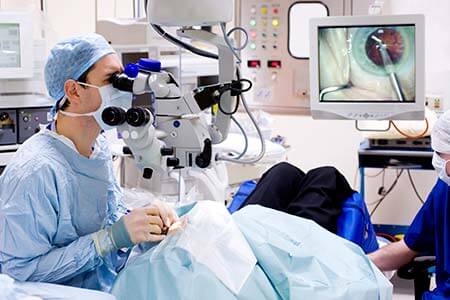The human lens is a transparent structure inside the eye that let's light into the eye. You develop cataracts when protein builds up in the lens of your eye, making the lens opaque, or cloudy. As a result, light does not pass through easily, and vision becomes blurry, like looking through a foggy or dusty car windshield. Things look blurry, hazy, or less colorful with a cataract. The cloudier the lens, the worse the vision will be.
Congenital cataracts may be present at birth or appear shortly after, or at some time during infancy or childhood.
Age-related cataracts appear later in life and are the most common type.
Cataracts are the leading cause of vision loss in people over the age of 40, but cataract surgery is a routine operation and the most common kind of eye surgery.

The most common symptoms of a cataract are:
These symptoms also can be a sign of other eye problems.
If you have any of these symptoms, call our San Antonio office at ☎ (210) 806-0022 or contact us online to schedule a comprehensive eye exam.
Cataracts are detected through a comprehensive eye exam that includes:
Many people consider poor vision an inevitable fact of aging, but cataracts
surgery is a simple, relatively painless procedure to regain vision. Cataract
surgery is very successful in restoring vision. In fact, it is the most
frequently performed surgery in the United States. Nine out of 10 people who
have cataract surgery regain very good vision, somewhere between 20/20 and
20/40.

During surgery, the cataract surgeon will remove your clouded lens and in most cases replace it with a clear, plastic intraocular lens (IOL).
Today you have many types of IOLs to choose from for your cataract surgery, depending on your specific needs. In addition to IOLs that correct nearsightedness and farsightedness, there are now “Toric” IOLs that correct astigmatism as well.
If you don't mind wearing glasses after cataract surgery, a “monofocal” lens implants usually are used. Often, only part-time use of reading glasses is needed after cataract surgery with mono-focal IOLs. But if prescription eyeglasses are needed (which often is the case if you only need cataract surgery in one eye), your eye doctor typically will prescribe new glasses for you approximately one month after surgery.
If you like the idea of being less dependent on glasses after a cataract surgery, one way to correct presbyopia and reduce your need for reading glasses is to have your cataract surgeon adjust the power of one of your mono-focal IOLs (assuming you have cataract surgery performed in both eyes) to give you a monovision correction, meaning you will have one eye corrected for near vision and one eye corrected for distance vision – similar to monovision with contact lenses.
Another option is to choose one of a variety of advanced presbyopia-correcting IOLs to improve your reading vision without sacrificing your distance vision. Presbyopia-correcting IOLs include accommodating IOLs and multifocal IOLs; both types are designed to provide a greater range of vision after cataract surgery than conventional mono-focal IOLs.
Be aware that not everyone is a good candidate for these premium IOLs, and choosing a presbyopia-correcting IOL will increase the out-of-pocket cost of your cataract surgery since the added cost of these advanced lens implants is not covered by Medicare or other insurance plans.
Prior to cataract surgery, in addition to discussing the different types of IOLs, you will be advised about what to expect before, during, and after your procedure. This information — which may be presented orally, in writing, via a video presentation, or a combination of all three — is meant to help you make an informed decision about whether to proceed with surgery. Our doctor and staff will answer any and all questions or concerns about cataract surgery, prior to you signing the "informed consent" documents authorizing surgery.
Laser Cataract Surgery (or, more accurately, laser-assisted cataract surgery) is fairly new and significantly increases cataract surgery costs, primarily because the laser can cost from $300,000 to $500,000 for a cataract surgeon to purchase and there are other significant costs associated with the use and maintenance of this technology.
While laser-assisted cataract surgery is an alternate technique now available, it may not necessarily improve cataract surgery safety, recovery time, and visual outcomes in every case. The latest information about laser-assisted cataract surgery can be discussed after your comprehensive eye exam and cataract surgery consultation.
To request more information, call ☎ (210) 806-0022 or contact us online.
Baribeau Cataract and Laser
4025 East Southcross Blvd, Building 4, Suite 20
San Antonio, TX 78222
Phone:
(210) 806-0022
Get Directions